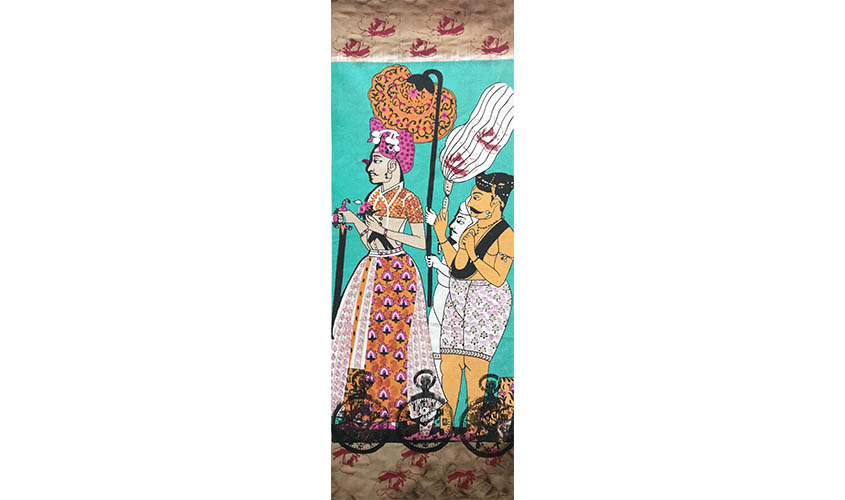Organised by the Lalit Kala Akademi, the International Print Biennale in Delhi features artworks by over a hundred emerging and established printmakers from across the world, with a view to promoting the forgotten art of printmaking, writes Bhumika Popli.
In the world of visual arts, lesser forms lurk behind the shadows of painting and sculpture. One such form is printmaking, easily among the least talked about art practice in India. In an attempt to familiarise people with the basics of this medium, the Lalit Kala Akademi, for the first time in Delhi, has organised an International Print Biennale.
The programme runs till 20 April, and features two exhibitions, various workshops and seminars—all with the idea to prepare the next batch of printmakers on these shores.
One of the shows is mounted at the Akademi’s Rabindra Bhavan Gallery. There are around 200 prints on display, 73 of which are by artists from places as far afield as the USA, UK, Poland, Argentina, Nepal, and so on. The second show, titled The Eminent Printmakers of India, is on view at Delhi’s National Gallery of Modern Art, and it comprises 98 printmakers of great repute—figures such as Sanat Kar, Jyoti Bhatt, Laxman Goud, and K.G. Subramanyan among others. An issue of Samkaleen Kala journal and monographs on two eminent printmakers Sanat Kar and Jyoti Bhatt are also being published as part of the ongoing biennale.

For Preeti Singh, a Delhi-based printmaker, whose work is featured at the Rabindra Bhavan exhibition, this event is valuable. “The recent and the olden works presented at the same time offer a layout which helps artists like me to decipher the progress in printmaking—where we are coming from, what we need to learn and where we can go.”
There are four techniques that can be used for printmaking, including relief, intaglio, planography and stencil. Here images are transferred from one surface to another.
Nowadays this form of art is also created digitally. Printmaking is a newer art form as compared to painting. It came to India in 1556 and the earliest surviving print is Compendio Spiritual da Vide Christaa (Spiritual Compendium of Christian Life) by Gaspar De Leo. It was printed in Goa in 1561.
“Printmaking in India is a recent form,” says National Award-winner Ananda Moy Banerjee, a part of the steering committee which led the International Print Biennale. “The understanding of this art form is not yet established very naturally in India. When you see a print it is not a copy, it is similar to an edition of any good book. Just like a good book where the quality doesn’t go down with newer printed editions, similarly, prints also have multiple originals and hence the art requires much appreciation. This kind of positivity will take time to develop because first of all the form is quite new and secondly, even the system of art education in schools is not really developed.”
In India, many societies and groups are nevertheless working to promote printmaking—organisations such as Chaap, Multiple Encounters and so on. Anupam Sud, the commissioner of the steering committee and a renowned printmaker herself, has organised many activities to promote printmaking in the past. She says, “We have done a number of printmaking camps all over India. We would demonstrate the process of making prints to everyone who was willing to learn. There is a lot of confusion among people about this art form. They know very little about it. People used to photo-process the paintings and made reproductions of those. They signed the reproductions and called them ‘prints’ which is a wrong way to promote printmaking. Print means that the basic or master plate is made by printmakers. For each edition, artist works from the plate and prints it, unlike a reproduction. The prints are called editions. It is a laborious process. Till 2010, Bharat Bhavan in Bhopal used to organise the International Print Biennale, but it stopped. It was the dream of the administrator of Lalit Kala Akademi, C.S. Krishna Setty, who is a prominent printmaker himself.”
Setty undertook extensive research during 1981-82 in graphics at the Garhi Studios, New Delhi, under Lalit Kala Akademi’s scholarship. Talking about his endeavour, he says, “I was working under Dakoji Devraj, a renowned printmaker in Garhi, and since that time, I have wanted the Akademi should do something around printmaking but it never happened in 64 years of the Akademi. This was the primary reason I initiated this programme and ultimately made it happen.”

